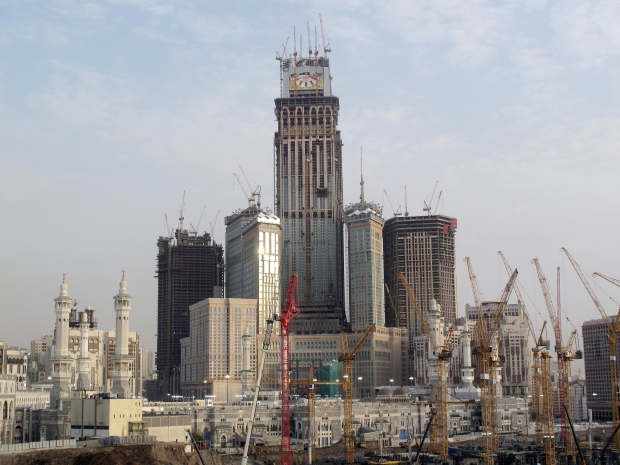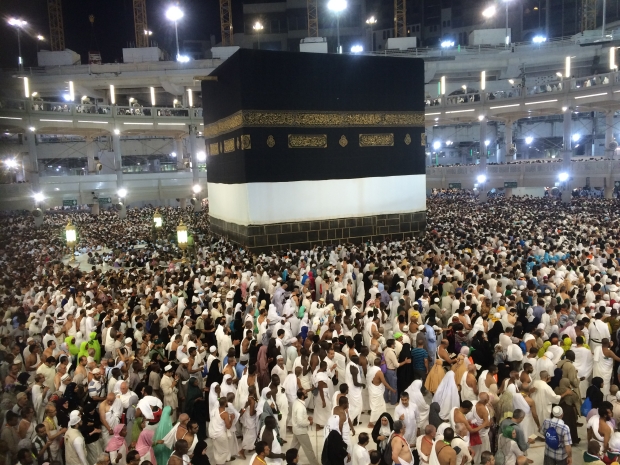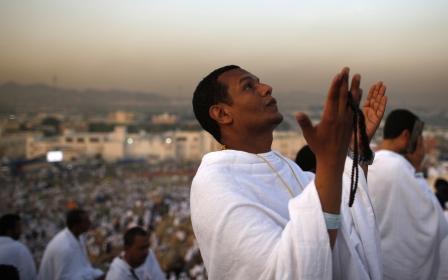Is Saudi Arabia pricing poorer pilgrims out of Hajj?

With its glittering skyscrapers, ritzy hotels, and sprawling shopping malls, it is hard to believe Mecca was ever a simple dusty, desert town where the likes of Abraham, Hagar and Muhammad once roamed. The transformation to the landscape over the last few decades has been swift and irreversible.
Both staggering poverty and opulence are on full display in Mecca during the annual Hajj season, which began last week. Huddled masses of pilgrims from all over the world lie sprawled out on blankets on the floor of the courtyard outside the main mosque. They include the African family of five who lie asleep with all their belongings at the front door of the high-rise shopping mall and hotel just adjacent to the Grand Mosque, to the thousands of panhandlers who set up camp each year in the Tent City of Mina, selling scarves, slippers, toys – anything in the hope that foreign pilgrims will give generously.
In some senses, Mecca has not actually changed as a place of refuge for the millions of pilgrims who flock there each year. But the simple resting places of these poorer pilgrims lie in the long shadows cast by the looming clock tower and decadent hotels, which they could never afford, surrounding the Grand Mosque.
The Hajj is a spiritual pilgrimage that every financially and physically able Muslim is required to carry out at least once in their lifetime. And yet Islam’s holiest city has undergone an unprecedented transformation that panders to the interests of the Saudi tourism and hospitality sector, seemingly above the spiritual needs of the many. This means that what is typically regarded as an unostentatious journey aimed at humbling the human soul has become a top-tier “experience” destination for some.
According to Dr Ahmad al-Alawi, the executive director of the Islamic Heritage Research Foundation in Mecca, all the luxury hotel developments – both older and newer ones – have been built on the Ajyad Fortress, a sprawling stone citadel built in the Ottoman era. When the fortress and the ancient mountain it sat on were flattened in 2002, Turkey’s then-culture minister called it a "cultural massacre". In 1984, the house of the prophet's wife, Khadijah, was also destroyed to make way for public lavatories.
“You certainly wouldn’t find anything like this in Rome or the Vatican,” says Dr al-Alawi. “Why would anyone construct a hotel with sunbathing beds on the canopies as if you were next to the beach?” he asks, in reference to the luxury hotels that already exist outside the Grand Mosque. “Even the gyms have full blown glass windows in front of you… So if you’re on a treadmill you can have a view overlooking the Kaaba. My concern is that it [the Abruj Kudai] will not only become a holiday resort, but an excuse to wipe away Mecca and Medina's heritage.”
The world's largest hotel, helipads and all
The development of the world’s largest hotel, the $3.5bn Abraj Kudai luxury hotel in Mecca, just adjacent to the Grand Mosque, is the greatest driver of that transformation. The Abraj Kudai will feature 12 towers, 10,000 rooms, 70 restaurants and four helipads. It is expected to cover 15 million square feet and rise 45 storey’s high by the time it opens.
The need to accommodate for a massive growth in pilgrims - from 1.2 million in 1997 to 2.9 million in 2011 - is what the Saudis say is behind the decision to construct the Abraj Kudai. But given that most pilgrims travel from developing countries, is building hotel rooms that cost anywhere from $1,800 to $2,500 a night really going to fix the problem of a shortage of rooms?
Some observers believe it has more to do with a strategic effort on Riyadh’s part to project a different face of the city. “I think that the government wants to make pilgrimage an unforgettable experience,” says Tarik Dogru, a professor of hospitality and tourism at Boston University.
Although other luxury hotels have existed around the Grand Mosque for almost a decade, a hotel of this scale would likely change Mecca’s image as a destination, he adds.
“The Saudi government saw a potential in which there is demand and a market niche that needs to be filled. The hotel will offer an 'experience' which many people are willing to pay for because the pilgrimage is a once in a lifetime experience for most people, and they save for it for their whole lives," Dogru said.
Mecca money-spinner
Building a vibrant metropolis aimed at affluent travellers looking for something a little more than spiritual revival may also be one way to lift Saudi from its economic woes. Riyadh relies upon oil sales for more than 90 percent of its revenue, so when oil prices fell from $100 a barrel to $30 a barrel this year, oil revenues collapsed and the kingdom lost $390bn in anticipated profits. It now carries a fiscal deficit of $100bn.
But revenues from religious pilgrimages in Saudi generate up to $18bn a year, so it is perhaps not surprising that Riyadh would turn to Hajj tourism for a big opportunity to turn the millions of visitors into assets. Dogru predicts the Abruj Kudai will project a different image of Saudi Arabia to the world – one beyond its massive reserves of oil. “This hotel could be a centre for prospective investors that have interests in this market,” he says.
And the growth in luxury accommodation should not affect business in smaller and mid-size hotels, he adds. “These hotels appeal to visitors of different income levels. Nonetheless, it is very likely to place some shadow on the existing luxury hotels, such as Mecca Royal Clock Tower Hotel (named for the looming 76-floor Big Ben-like Clock Tower that currently overlooks the Grand Mosque). Overall, however, I expect the tourism industry will experience a positive shift.”
But some critics say the aggressive campaign of construction and development underway in the city over the past two decades comes at a steep cost. In a film documenting Mecca’s urban transformation, Saudi artist Ahmed Mater says he believes the rapid commercial development is having a real impact on the “mental, spiritual and physical health” of the worldwide Muslim community. “To go to the Mecca is the ultimate journey of your life. It’s the journey that when you go, you write your will before you go. But it is no longer like it should be.”
Concerns also exist over how sustainable the newer development projects are. Since oil prices plummeted, construction for the Abraj Kudai and several other projects have been at a standstill. Earlier this year, the Binladin Group, the Saudi construction company closest to the government, sacked thousands of its workers to avert financial disaster. Workers in Jeddah, Mecca and Riyadh publicly protested, saying they had not been paid for months, and one company bus was set alight. One report estimates that all of the development projects cost over $26bn, not including a reported $35bn for the real estate alone.
Feeling the pinch
Foreign pilgrims too may feel the pinch. It already costs 9,000 pounds ($12,000) on average for a Muslim from the UK to travel to Mecca – a steep climb from about 3,000 pounds ($4,000) in 2010.
When the Abraj Kudai and other seven star hotels are completed, Dr al-Alawi believes the cost of accommodation at nearby hotels will also rise significantly and middle-class pilgrims will need to stay three to four miles away from the Grand Mosque and take taxis - which charge quadruple the normal rate (about $9) during the Hajj season.
He suggests more affordable four- or five-star hotels like the Hilton and Holiday Inn be built to accommodate growing numbers of pilgrims. “There used to be many hotels like this 20 years ago,” he says. “Those have been demolished in favour of luxury hotels, which many of the [Saudi] princes have shares in.”
For others, the investments the Saudi government have made to turn the city into a thriving metropolis and holiday experience are to be applauded. “Such developments are believed by some to be befitting and admirable for Mecca and Kaaba, the birthplace of the Prophet Muhammad,” says Dogru.
The reactions of pilgrims are mixed. "The Royal Clock Tower makes it easier to socialise, shop and spend less time in the haram {sanctuary],” observes Hanna Chandoo, a lawyer who travelled for Hajj this year from California. “These are not necessarily bad things. But they are not the point of Hajj, in my opinion. As someone who comes from the West though it's easy for me to be disgusted by large, unnecessary, lavish structures in Arab countries – which are usually malls.
“Perhaps it's because I leave America to leave consumerism and all that it represents,” she adds. “And so when confronted with consumerism - during a trip that specifically focuses on detaching from the world and consumerism - maybe I have a stronger reaction to this than others coming from other countries.”
Sustainability and cultural destruction aside, some argue that the increasingly flashy skyline of Mecca does not reflect the sacredness of a city that gave rise to one of the world’s largest religions – and a prophet who Muslims believe espoused a modest lifestyle.
“Mecca has lost its spirituality as being the city with the House of God,” argues Dr al-Alawi. “Because when you’re in the Grand Mosque and you look up and see those cranes and clock tower, you think: Am I really in Mecca or Manhattan?”
This article is available in French on Middle East Eye French edition.
Middle East Eye propose une couverture et une analyse indépendantes et incomparables du Moyen-Orient, de l’Afrique du Nord et d’autres régions du monde. Pour en savoir plus sur la reprise de ce contenu et les frais qui s’appliquent, veuillez remplir ce formulaire [en anglais]. Pour en savoir plus sur MEE, cliquez ici [en anglais].






